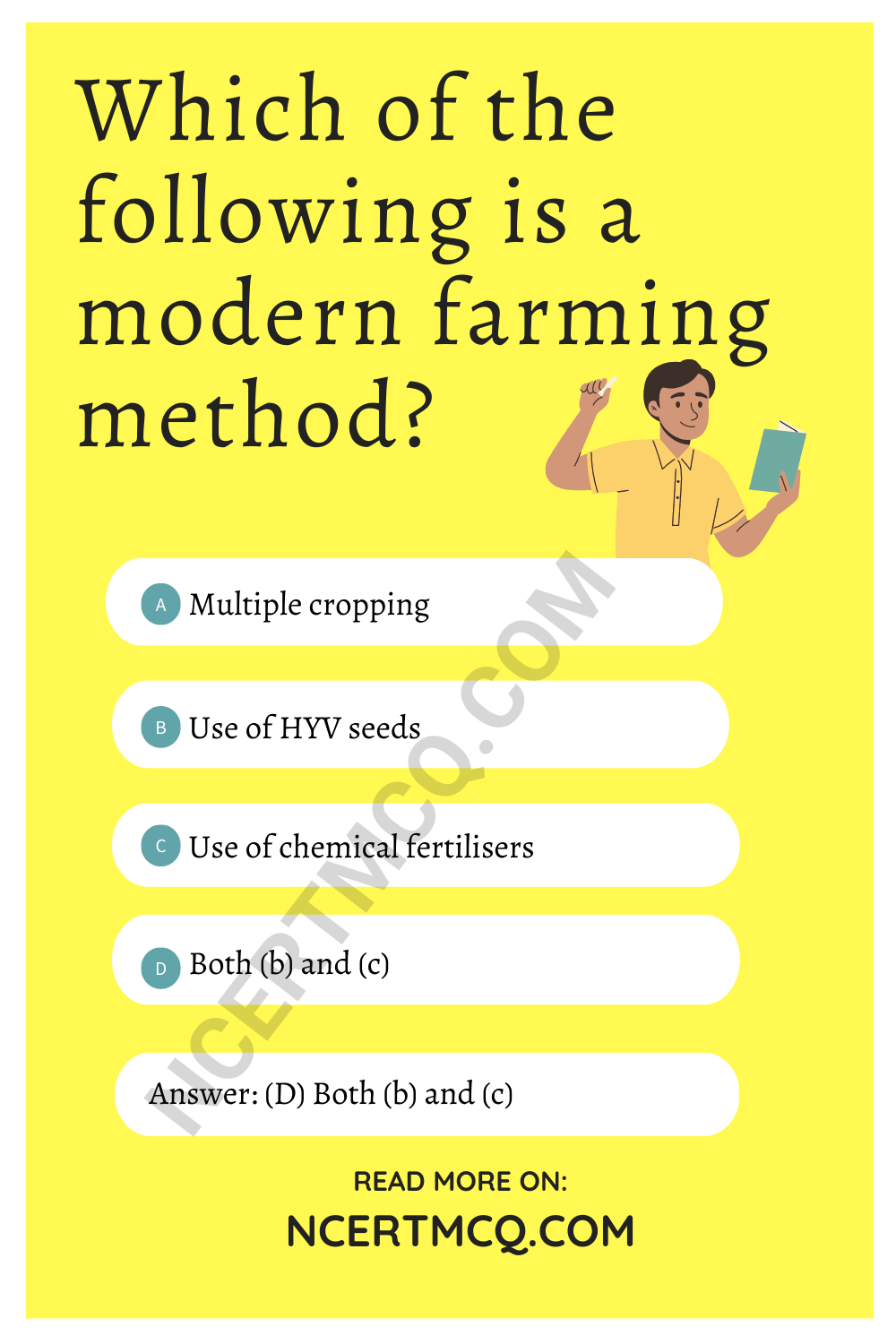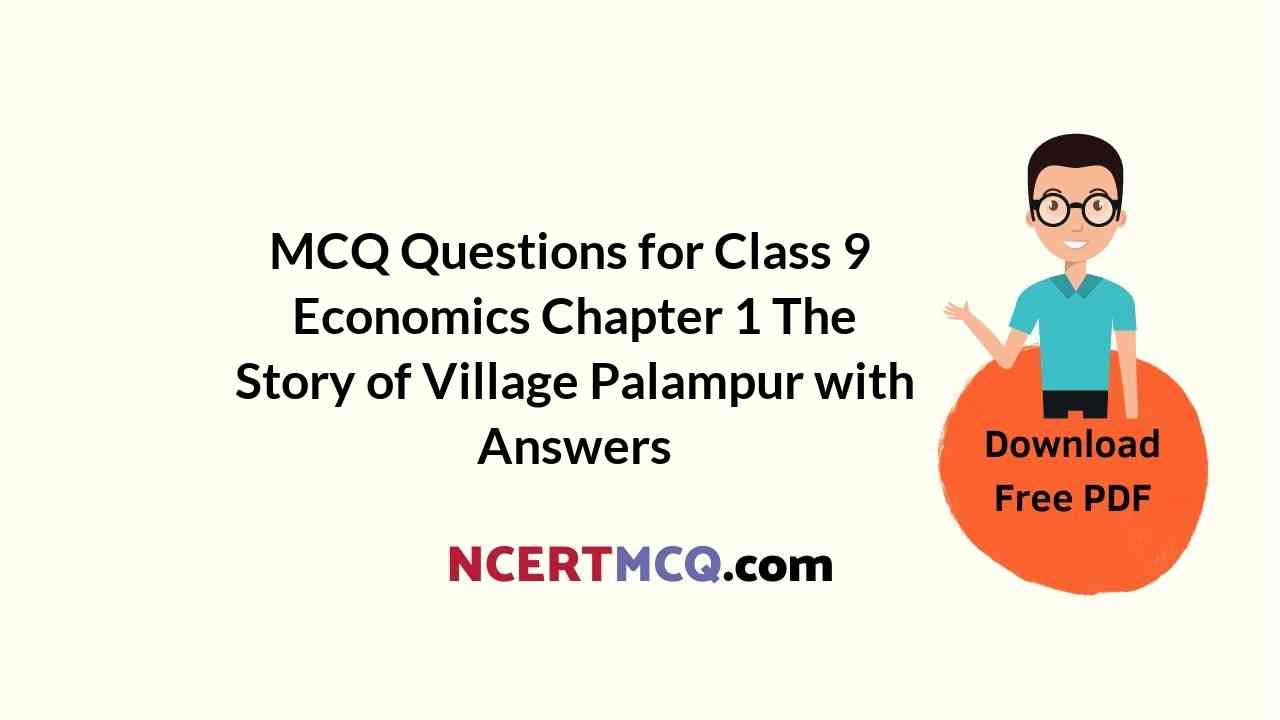Check the below Online Education NCERT MCQ Questions for Class 9 Economics Chapter 1 The Story of Village Palampur with Answers Pdf free download. MCQ Questions for Class 9 Social Science with Answers were prepared based on the latest exam pattern. We have Provided The Story of Village Palampur Class 9 Economics MCQs Questions with Answers to help students understand the concept very well. https://ncertmcq.com/mcq-questions-for-class-9-social-science-with-answers/
Class 9 Social Science Economics Chapter 1 MCQ With Answers
Economics Class 9 Chapter 1 MCQs On The Story of Village Palampur
Choose the correct option:
The Story Of Village Palampur MCQ Question 1.
‘Bigha’ and ‘Guintha’ are
(a) the type of village house
(b) the type of hybrid seeds
(c) the measuring units of grain
(d) the measuring units of land area in village
Answer
Answer: (d) the measuring units of land area in village
Class 9 Economics Chapter 1 MCQ With Answers Question 2.
Finance raised to operate a business is called
(a) labour
(b) enterprise
(c) land
(d) capital
Answer
Answer: (d) capital
Class 9 Economics Chapter 1 MCQ Question 3.
Minimum wages for a farm labourer set by the government is
(a) ₹80
(b) ₹90
(c) ₹115
(d) ₹120
Answer
Answer: (c) ₹115
The Story Of Village Palampur Class 9 MCQ Question 4.
The Green Revolution introduced the farmers to
(a) cultivation of wheat and rice
(b) cultivation of green vegetables
(c) cultivation of sugar cane
(d) cultivation of forests
Answer
Answer: (a) cultivation of wheat and rice
Story Of Village Palampur MCQ Question 5.
The small farmers constitute about _________ per cent of total farmers in India.
(a) 50
(b) 60
(c) 70
(d) 80
Answer
Answer: (d) 80
Economics Class 9 Chapter 1 MCQ Question 6.
The new ways of farming need
(a) less land
(b) more capital
(c) machinery
(d) all of the above
Answer
Answer: (d) all of the above
The Village Of Palampur Class 9 MCQ Question 7.
The most abundant factor of production is
(a) labour
(b) land
(c) machinery
(d) all of the above
Answer
Answer: (a) labour

Economics Chapter 1 Class 9 MCQ Question 8.
Multiple Cropping refers to :
(a) Cultivation of wheat and rice
(b) cultivation of two crops in alternate rows
(c) cultivating more than one crop on the same field each year
(d) cultivating crops and rearing animals on the same farm
Answer
Answer: (c) cultivating more than one crop on the same field each year
Ch 1 Economics Class 9 MCQ Question 9.
Working capital stands for :
(a) Tools, machines and buildings
(b) raw materials and money in hand
(c) total share capital
(d) fixed deposits in financial institutions
Answer
Answer: (b) raw materials and money in hand
Story Of Village Palampur Class 9 MCQ Question 10.
Which one of the following is not an effect of the modern farming?
(a) Soil degradation
(b) Deforestation
(c) Decrease in groundwater
(d) Water pollution
Answer
Answer: (d) Water pollution
MCQ Questions For Class 9 Economics Chapter 1 Question 11.
How many families lives in Village Palampur?
(a) 150
(b) 250
(c) 350
(d) 450
Answer
Answer: (d) 450
Economics Ch 1 Class 9 MCQ Question 12.
Where do most of the small farmers borrow money to arrange for the capital in Palampur?
(a) Banks
(b) Co-operative Societies
(c) Village money lenders
(d) Friends and relatives
Answer
Answer: (c) Village money lenders
Class 9th Economics Chapter 1 MCQ Question 13.
‘Operation Flood’ is related to :
(a) control flood
(b) produce fish
(c) milk production
(d) grain production
Answer
Answer: (c) milk production
Class 9 Economics Chapter 1 MCQ Online Test Question 14.
Consumption of chemical fertilisers is highest in which state of India?
(a) Punjab
(b) Haryana
(c) Rajasthan
(d) Himachal Pardesh
Answer
Answer: (a) Punjab
Village Palampur Class 9 MCQ Question 15.
Scope of farming activity is limited in Palampur due to
(a) Fixed amount of land
(b) lack of irrigation
(c) lack of labour
(d) none of the above
Answer
Answer: (a) Fixed amount of land
Question 16.
Who is a person who puts together land, labour and capital?
(a) Moneylender
(b) Entrepreneur
(c) Zamindar
(d) Manager
Answer
Answer: (b) Entrepreneur
Question 17.
High Yielding Variety (HYV) seeds are developed in
(a) Research institutes
(b) Factories
(c) Krishak Bharati Cooperatives
(d) None of the above
Answer
Answer: (a) Research institutes
Question 18.
Which Kharif crop is used for cattle feed?
(a) Sugarcane
(b) Potato
(c) Jowar and bajra
(d) Wheat
Answer
Answer: (c) Jowar and bajra
Question 19.
Which of the following is a modern farming method?
(a) Multiple cropping
(b) Use of HYV seeds
(c) Use of chemical fertilisers
(d) Both (b) and (c)
Answer
Answer: (d) Both (b) and (c)

Question 20.
Which area in India has a low level of irrigation?
(a) Deccan plateau
(b) Coastal regions
(c) Riverine plains
(d) Both (a) and (b)
Answer
Answer: (a) Deccan plateau
Question 21.
Multiple cropping means growing
(a) only two crops
(b) only three crops
(c) upto four crops
(d) more than one crop
Answer
Answer: (d) more than one crop
Question 22.
HYV seeds stands for
(a) Heavy yielding variety seeds
(b) High yielding variety seeds
(c) Half yielding variety seeds
(d) None
Answer
Answer: (b) High yielding variety seeds
Question 23.
The minimum wages for a farm labourer set by the government is
(a) Rs. 50
(b) Rs. 60
(c) Rs. 70
(d) Rs. 80
Answer
Answer: (b) Rs. 60
Question 24.
Which of the following is fixed capital?
(a) Tools and machines
(b) Fertilisers and pesticides
(c) Soil
(d) Seeds
Answer
Answer: (a) Tools and machines
Question 25.
Which of the following is grown in the rainy season?
(a) Jowar and bajra
(b) Wheat
(c) Soyabean
(d) Rice
Answer
Answer: (a) Jowar and bajra
Suggested Activities
During your field visit talk to some farmers of your region. Find out:
- What kind of farming methods—modem or traditional or mixed—do the farmers use? Write a note.
- What are the sources of irrigation?
- How much of the cultivated land is irrigated? (very little/nearly half/majority/all)
- From where do farmers obtain the inputs that they require?
Answer
Answer:
- Most of the farmers in my region use modem farming methods. However, some are still carrying on traditional methods. These farmers are too poor to follow modem farming methods which need more cash.
- Wells and tubewells.
- Majority of the cultivated land is irrigated.
- Farmers obtain the required inputs from the local markets. The money that they need to buy the inputs either comes from their own savings or they take a loan from the bank.
Fill in the Blanks
Among the three factors of production, we found that labour is the most abundant factor of production. There are many people who are willing to work as farm labourers in the villages, whereas the opportunities of work are limited. They belong to either landless families or
1. ______ They are paid low wages, and lead a difficult life In contrast to labour
2. ______ is a scarce factor of production. Cultivated land area is
3. ______ Moreover, even the existing land is distributed.
4. ______ among the people engaged in farming there are a large number of small farmers who cultivate small plots of land and live in conditions not much better than the landless farm labourer. To make the maximum use of the existing land, farmers use
5. ______ and
6. ______ Both these have led to increase in production of crops. Modem farming methods require a great deal of
7. ______ Small farmers usually need to borrow money to arrange for the capital, and are put to great distress to repay the loan. Therefore, capital too is a scarce factor of production, particularly for the small farmers. Though both land and capital are scarce, there is a basic difference between the two factors of production.
8. ______ is a natural resource, whereas.
9. ______ is man-made. It is possible to increase capital, whereas land is fixed. Therefore, it is very important that we take good care of land and other natural resources used in farming.
Answer
Answer:
1. Families cultivating small plots of land
2. land
3. fixed
4. unequally
5. HYV seeds
6. chemical fertilisers
7. capital
8. Land
9. capital
We hope the given NCERT MCQ Questions for Class 9 Economics Chapter 1 The Story of Village Palampur with Answers Pdf free download will help you. If you have any queries regarding The Story of Village Palampur CBSE Class 9 Economics MCQs Multiple Choice Questions with Answers, drop a comment below and we will get back to you soon.
Class 9 Social Science Economics MCQ:
